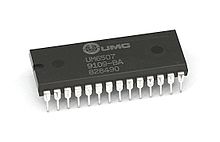
Back معالج موس تكنولوجي 6507 Arabic MOS Technology 6507 Catalan MOS Technology 6507 German MOS 6507 Spanish MOS Technology 6507 French MOS Technology 6507 Croatian MOS 6507 Italian MOS 6507 Japanese MOS 6507 Korean MOS Technology 6507 Polish
 | |
| General information | |
|---|---|
| Launched | 1975 |
| Common manufacturer | |
| Performance | |
| Data width | 8 |
| Address width | 13 |
| Architecture and classification | |
| Instruction set | 6502 |
| Number of instructions | 56 |
| Physical specifications | |
| Transistors | |
| Package |
|
| History | |
| Predecessors |
|
The 6507 (typically "sixty-five-oh-seven" or "six-five-oh-seven") is an 8-bit microprocessor from MOS Technology, Inc. It is a version of their 40-pin 6502 packaged in a 28-pin DIP, making it cheaper to package and integrate in systems.[3] The reduction in pin count is achieved by reducing the address bus from 16 bits to 13 (limiting the available memory range from 64 KB to 8 KB) and removing a number of other pins used only for certain applications.[4]
To do this, A15 to A13 and some other signals such as the interrupt lines are not accessible. As a result, it can only address 8 KB of memory, which for some applications at the time (1975) was acceptable and not overly restrictive. The entire 6500 CPU family was originally conceived as a line of very low-cost microprocessors for small-scale embedded systems.[5]
The 6507 and 6502 chips use the same underlying silicon layers, and differ only in the final metallisation layer. This ties the interrupt lines to their inactive level so they are not vulnerable to generating spurious interrupts from noise. The first three digits of the chip identifier are part of the silicon layers, and the final digit is in the metallisation layer. Micro-photography of the 6502 and 6507 shows this difference.[6]

The 6507 is widely used in two applications: the best-selling Atari 2600 video game console[7] and peripherals for the Atari 8-bit computers including the 850 Serial & Parallel Interface,[8] and the 810 and 1050 disk drives.[9][10] In the 2600, the system is further limited by the design of the ROM cartridge slot, which only allows for 4 KB of the external memory to be addressed. The other 4 KB is reserved for the internal RAM and I/O chips, using a minimal-cost partial decoding technique that causes the RAM and peripheral device registers to appear at multiple aliased addresses throughout the 4 K address space.[11]
Most other machines, notably home computers based on the 650x architecture, use either the standard 6502 or extended versions of it, in order to allow for more memory.
By the time the 6502 line was becoming widely used around 1980, ROM and RAM semiconductor memory prices had fallen to the point where the 6507 was no longer a worthwhile simplification. Its use in new designs ceased at that point, though the Atari 2600 that contains it continued to be sold into the early 1990s, as it was not discontinued until January 1, 1992. However, late-model Atari 2600 consoles do not necessarily contain a discrete 6507 chip.
- ^ "The MOS 6502 and the Best Layout Guy in the World". swtch.com. 2011-01-03. Retrieved 2014-08-09.
- ^ "MOnSter6502". monster6502.com. 2017. Retrieved 2017-05-01.
- ^ Bagnall, Brian. Commodore. Variant Press.
We sold a microprocessor, RAM, ROM, and I/O chip all for twelve bucks, ...
- ^ Bagnall, Brian. Commodore. Variant Press.
The 6507, which was a subset of [the 6502], could be made at a cheaper price. It was designed to be a really small package.
- ^ "Oral History of Charles Ingerham "Chuck" Peddle" (PDF). June 12, 2014. p. 58. Retrieved 2021-05-30.
You don't use a 68000 as a logic replacement; you use it as a computer. And that's a different architecture. And we weren't capable of going there, without a major investment, ... It's supposed to have been in every cash register, it's supposed to have been in every intelligent thing on the airplane, it was supposed to be everywhere.
- ^ Visual6502. "Visual6502.org: 6502 vs. 6507".
{{cite web}}: CS1 maint: numeric names: authors list (link) - ^ "When Pac Ruled the Earth". Electronic Gaming Monthly. No. 62. EGM Media, LLC. September 1994. p. 18.
- ^ "Atari 850 Interface Module Field Service Manual". Internet Archive. 1981. Retrieved 2021-06-03.
Block Diagram
- ^ "Atari 810 Disk Drive Field Service Manual". Internet Archive. 1980. Retrieved 2021-06-03.
Block Diagrams And Schematics
- ^ "Service Manual For The Atari 1050 Disk Drive". Internet Archive. 1983. Retrieved 2021-06-03.
Electronic Theory
- ^ "Atari 2600 Specifications". Retrieved 2021-05-31.
Memory Mirrors
© MMXXIII Rich X Search. We shall prevail. All rights reserved. Rich X Search